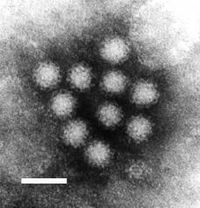
Photo from wikipedia
Human noroviruses impose a considerable health burden globally. Here, a flow cytometry approach designed for their detection in biological waste and food samples was developed using antibody-coated magnetic beads. Antipeptide… Click to show full abstract
Human noroviruses impose a considerable health burden globally. Here, a flow cytometry approach designed for their detection in biological waste and food samples was developed using antibody-coated magnetic beads. Antipeptide antibodies against murine norovirus and various human norovirus genotypes were generated for capture and coated onto magnetic beads. A flow cytometry assay was then implemented to detect bead-bound human norovirus GI.3 in patient stool samples and in norovirus-spiked mussel digestive tissues. The detection limit for stool samples was 105 gc/mL, thus bettering detection limits of commercially available norovirus diagnosis quick kits of 100-fold; the detection limit in spiked mussels however was ten-fold higher than in stool samples. Further assays showed a decrease in fluorescence intensity for heat- or UV-inactivated virus particles. Overall, we demonstrate the application of a flow cytometry approach for direct detection of small non-enveloped virus particles such as noroviruses. An adaptation of the technology to routine diagnostics has the potential to contribute a rapid and sensitive tool to norovirus outbreak investigations. Further improvements to the method, notably decreasing the detection limit of the approach, may allow the analysis of naturally contaminated food and environmental samples.
Journal Title: Food and environmental virology
Year Published: 2021
Link to full text (if available)
Share on Social Media: Sign Up to like & get
recommendations!